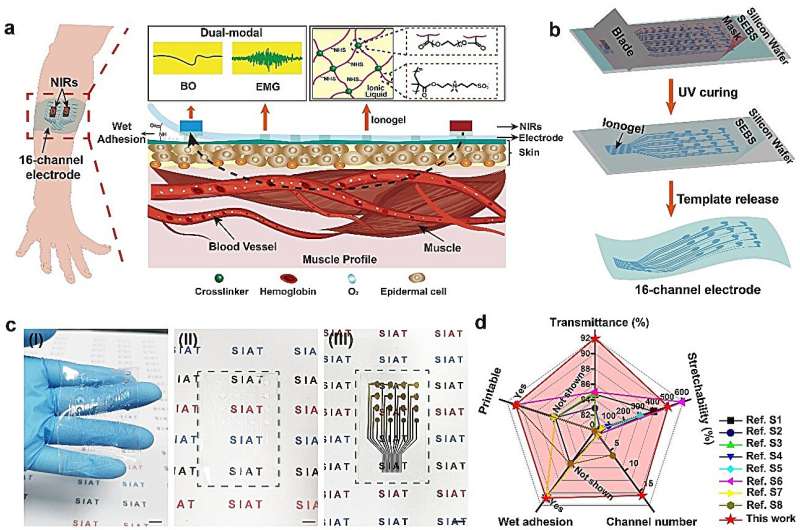Schematic illustration of stretchable multi-channel ionotronic electrodes for in-situ dual-modal monitoring of muscle–vascular activity. Credit: SIAT
In-situ dual-modal detection of electrophysiology and blood oxygen during muscle–vascular activity requires an integrated monitoring system comprising a transparent electrode for electrophysiology detection directly adhered to skin and a near-infrared spectroscopy (NIRs) layer for blood oxygen detection.
While previous studies have utilized stretchable ionogels to achieve single-channel electrophysiology monitoring, the accomplishment of in-situ dual-modal monitoring of both electrophysiology and blood oxygen by a soft and stretchable patch has been unattainable.
Now, a research team led by Tian Qiong and Prof. Liu Zhiyuan from the Shenzhen Institute of Advanced Technology, Chinese Academy of Sciences, has developed transparent, stretchable, and skin-adherent multi-channel ionotronic electrodes that were seamlessly integrated with NIRs probes to enable in-situ dual-modal monitoring of muscle-vascular activity.
Their study was published in Advanced Functional Materials on Sept. 26.
The fabrication of highly transparent 16-channel ionotronics involves a process that includes scraping printing and UV curing of a newly developed anhydrous ionogel. The ionogel was fabricated by UV-crosslinking of functional monomers to form a basic network structure swelling with ionic liquid.
The ionogel exhibited excellent softness, high stretchability, strong wet-adhesion, stable contact impedance, and high transparency. Adhesion to the epidermis was achieved by incorporating N-hydroxysuccinimide groups that could establish chemical bonding with the amino group (-NH2) on skin surface.
These characteristics endow the electrode with sweat resistance and the capability for prolonged monitoring of electromyography and electrocardiography. Additionally, ionogels find application in the monitoring of electroencephalograph signals.
In contrast to Ag/AgCl hydrogel electrodes, ionogels maintain conformal adhesion to the skin even in the presence of sweating. This enables successful monitoring of electrooculogram signals during eye opening and closing, as well as the monitoring of alpha waves in the forehead.
"In contrast to thin-film stretchable gold electrodes, our transparent ionotronic electrodes display minimal interference with NIRs sensing, performing comparably to a condition where the skin is bare. This enables precise detection of blood oxygen levels," said Prof. Liu.
An in-situ negative correlation between the electrophysiology intensity and blood oxygen levels over time during muscle fatigue is distinctly observed with the transparent ionotronic electrode.
More information: Hang Zhao et al, Stretchable Multi‐Channel Ionotronic Electrodes for In Situ Dual‐Modal Monitoring of Muscle–Vascular Activity, Advanced Functional Materials (2023). DOI: 10.1002/adfm.202308686
Journal information: Advanced Functional Materials
Provided by Chinese Academy of Sciences
























